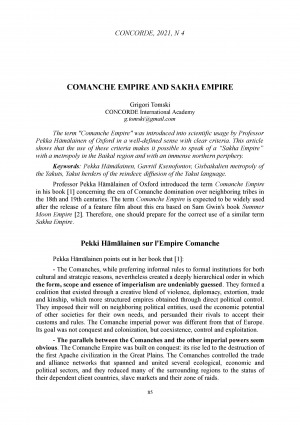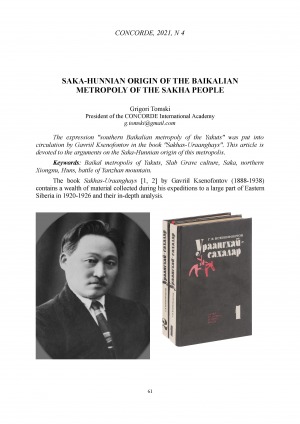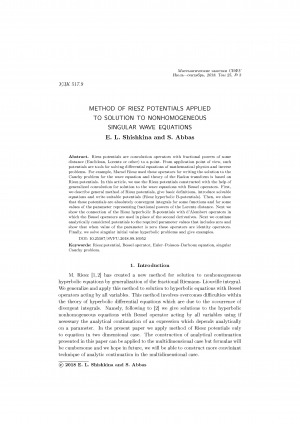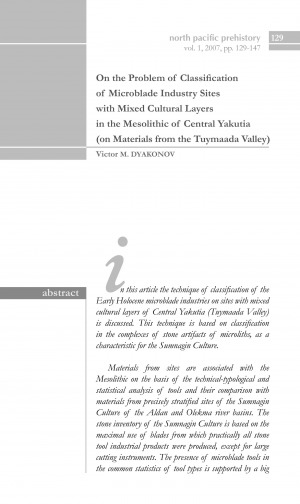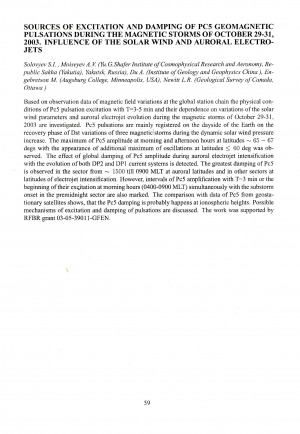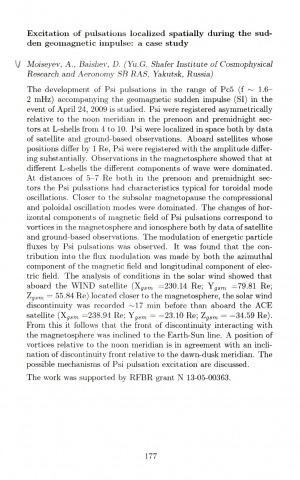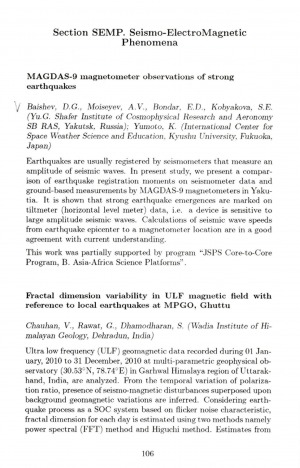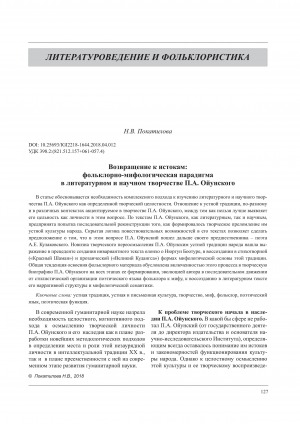Количество страниц: 12 с.
Tomski, G. V. Comanche empire and sakha empire / Tomski Grigori ; Académie internationale CONCORDE // Concorde. – 2021. – N 4. – С. 85-95.
Количество страниц: 14 с.
- Общественные науки. Образование > Этнография. Обычаи. Жизнь народа. Нравы,
- Краеведение. Археология. География. Биографии. История > Историческая наука. Историография > Всеобщая история. История отдельных стран и народов,
- НАУКА ЯКУТИИ > КРАЕВЕДЕНИЕ. ГЕОГРАФИЯ. БИОГРАФИИ. ИСТОРИЯ > Историческая наука. Историография > Всеобщая история,
- НАУКА ЯКУТИИ > ОБЩЕСТВЕННЫЕ НАУКИ > Этнография. Обычаи. Жизнь народа. Нравы.
Tomski, G. V. Saka-hunnian origin of the baikalian metropoly of the sakha people / Tomski Grigori ; Académie internationale CONCORDE // Concorde. – 2021. – N 4. – С. 61-74.
Количество страниц: 24 с.
Shishkina, E. L. Method of Riesz potentials applied to solution to nonhomogeneous singular wave equations / E. L. Shishkina, S. Abbas // Математические заметки СВФУ. — 2018. — Т. 25, N 3 (99), июль-сентябрь. — С. 68-91.
DOI: 10.25587/SVFU.2018.99.16952
Количество страниц: 19 с.
Работа посвящена проблеме изучения мезолита в Центральной Якутии. Здесь было известно небольшое количество стоянок сумнагинской культуры, характеризующихся смешанными культурными комплексами, и датированных этим временем лишь по аналогиям инвентаря. В работе предложена методика определения раннеголоценовых комплексов в смешанных культурных слоях, основанная на выделении в общих комплексах каменного инвентаря микролитов, в большей степени характерных для сумнагинской культуры. Проведённый анализ позволил выделить сумнагинский культурный комплекс на 11 памятниках Туймаады. На ещё около 25 памятниках, где обнаружены микропластинчатые индустрии, при расширении работ, может подтвердиться предположение о наличии в культурных слоях мезолитического каменного инвентаря
Dyakonov, V. M. On the Problem of Classification of Microblade Industry Sites with Mixed Cultural Layers in the Mesolithic of Central Yakutia (on Materials from the Tuymaada Valley) / Victor M. Dyakonov // North Pacific Prehistory : archaeological studies journal. — 2007. — Vol. 1. — P. 129-147.
Количество страниц: 1 с.
Sources of excitation and damping of PC5 geomagnetic pulsations during the magnetic storms of october 29-31, 2003 influence of the solar wind and auroral electrojets : [тезисы докладов] / Solovyev S. I., Moiseyev A. V., Mullayarov V. A., Du A., Engebretson M., Newitt L. R. // International symposium on Solar Extreme Events of 2003 : programme and abstract book. – Москва : УНЦ ДО, 2004. – P. 60.
Количество страниц: 1 с.
Sources of excitation and damping of PC5 geomagnetic pulsations during the magnetic storms of october 29-31, 2003 influence of the solar wind and auroral electrojets : [тезисы докладов] / Solovyev S. I., Moiseyev A. V., Du A., Engebretson M., Newitt L. R. // International symposium on Solar Extreme Events of 2003 : programme and abstract book. – Москва : УНЦ ДО, 2004. – P. 59.
Количество страниц: 1 с.
Moiseyev A. V., Excitation of pulsations localized spatially during the sudden geomagnetic impulse: a case study / Moiseyev A., Baishev D. // 10th International conference "Problems of geocosmos", St. Petersburg, Petrodvorets, October 6-10, 2014. – St. Petersburg : [s. n.], 2014. – P. 177.
Количество страниц: 1 с.
MAGDAS-9 magnetometers observations of strong earthquakes : [тезисы докладов] / Baishev D. G., Moiseev A.V., Bondar E. D., Kobyakova S. E., Yumoto K. // 10th International conference "Problems of geocosmos", St. Petersburg, Petrodvorets, October 6-10, 2014. – St. Petersburg : [s. n.], 2014. – P. 106.
Количество страниц: 4 с.
Solovyev, S. I. On the relation between the SYM-H and Dst- indices during the development of magnetic storm / S. I. Solovyev, R. N. Boroyev, A. V. Moiseyev // Physics of auroral phenomena : proceedings of the 28 th annual seminar, 1-4 March 2005. – 2005. – P. 48-51.
Количество страниц: 8 с.
- Общественные науки. Образование > Этнография. Обычаи. Жизнь народа. Нравы,
- Языкознание. Филология. Художественная литература > Литература. Литературоведение > Диссертации. Трактаты. Научная полемика,
- НАУКА ЯКУТИИ > ЯЗЫКОЗНАНИЕ. ФИЛОЛОГИЯ. ЛИТЕРАТУРОВЕДЕНИЕ. ХУДОЖЕСТВЕННАЯ ЛИТЕРАТУРА > Литература. Литературоведение,
- НАУКА ЯКУТИИ > ОБЩЕСТВЕННЫЕ НАУКИ > Этнография. Обычаи. Жизнь народа. Нравы.
The article substantiates the need for an integrated approach to the study of the literary and scientific creativity of P. Oyunsky as a certain creative integrity. The attitude of the oral traditions, in different ways and in different contexts focused in the work of P.A. Oyunsky, meanwhile, could not be better reveals his integrity as individuals in this matter. According to the texts of Oyunsky, both literary and scientific, an attempt was made to consistently reconstruct how the creative refraction of the oral culture of the people was formed. Hidden logic of narrative possibilities in texts Oyunsky allows us to make an assumption that in this matter he went further than his predecessor, the poet A.E. Kulakovsky. Novelty creative interpretation of P.A. Oyunsky oral traditions of the people found expression in the precedent of creating invariato text Olonkho about Nurgun Bootur. recreating in verse (“Red Shaman") and prose (“the Great Kudangsa”) forms the mythological basis of this tradition. The General trend of development of folklore material is due to the inclusion of this process in the creative biography of P. Oyunsky at all stages of its formation, the evolution of the author in a consistent movement from the stylistic organization of the poetic language of folklore to the myth, to the reconstruction in the literary text of its narrative structure and mythological semantics.
Покатилова, Н. В. Возвращение к истокам: фольклорно-мифологическая парадигма в литературном и научном творчестве П. А. Ойунского / Н. В. Покатилова // Северо-Восточный гуманитарный вестник. – 2018. – N 4 (25). – С. 127-134.
DOI: 10.25693/IGI2218-1644.2018.04.012
